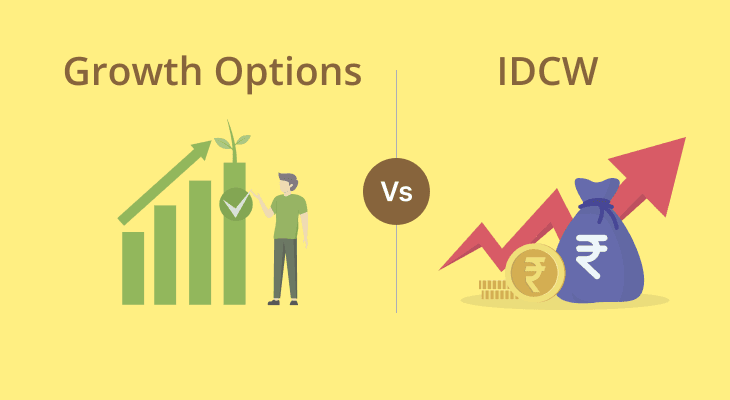
Growth Option vs IDCW: Which Mutual Fund Investment Strategy is Right for You?
Before investing, selecting the appropriate mutual fund investment strategy is crucial to achieve your financial objectives. Among the various options, two stand out – the Growth Option and the Income Distribution cum Capital Withdrawal (IDCW) Option. Understanding the distinctions between these strategies will help you in making informed investment decisions.
Understanding Growth Option and IDCW
Growth Option - H3
In the Growth Option, the mutual fund does not distribute any profits or dividends to investors. Instead, all earnings are reinvested back into the fund, leading to an increase in the Net Asset Value (NAV) over time. This approach is ideal for investors seeking capital appreciation and who do not require regular income from their investments.
Example and Calculation:
- Initial Investment: ₹ 50,000
- Initial NAV: ₹ 20
- Units Purchased: 2,500 (₹ 50,000 / ₹ 20)
Assuming the fund's value grows by 10% over the year:
- Fund Value After Growth: ₹ 55,000 (₹ 50,000 × 1.10)
- New NAV: ₹ 22 (₹ 55,000 / 2,500 units)
The investor's wealth increases due to the rise in NAV, reflecting capital appreciation. Naturally, the longer you stay invested, the power of compounding can help your wealth substantially.
Income Distribution cum Capital Withdrawal (IDCW) Option
Formerly known as the Dividend Option, IDCW provides investors with regular payouts from the fund's earnings. These payouts can be in the form of dividends and may include a portion of the invested capital, leading to a reduction in NAV after each distribution. This option suits investors seeking periodic income from their investments.
Example and Calculation:
- Initial Investment: ₹ 50,000
- Initial NAV: ₹ 20
- Units Purchased: 2,500 (₹ 50,000 / ₹ 20)
If the fund declares a dividend of ₹3 per unit:
- Dividend Payout: ₹7,500 (2,500 units × ₹ 3)
- NAV After Dividend: ₹17 (₹ 20 initial NAV - ₹ 3 dividend)
- Remaining Investment Value: ₹ 42,500 (2,500 units × ₹ 17)
The investor receives ₹7,500 as income, and the value of the remaining investment decreases accordingly.
Differences Between Growth Option and IDCW
Both the options have their own respective merits and applications. Understanding the key distinctions between these options is essential for aligning your investment strategy with your financial goals. Here’s a summary of the key difference between the two:
Parameter | Growth Option | IDCW Option |
Payout | No regular payouts; earnings are reinvested. | Regular payouts through dividends; may include a portion of the invested capital. |
Capital Appreciation | Profits reinvested, leading to compounding and NAV growth. | Payouts reduce NAV; capital appreciation may be limited due to regular withdrawals. |
Taxation | Taxes applicable upon redemption; treated as capital gains. | Dividends taxed as per the investor's income tax slab; payouts considered as income from other sources. |
Investment Horizon | Suitable for long-term investors aiming for wealth accumulation. | Ideal for investors seeking regular income, possibly with a shorter investment horizon. |
Risk Profile | Potential for higher returns with market-linked risks; suitable for investors with a higher risk tolerance. | Provides regular income with potentially lower capital growth; suitable for investors with a lower risk tolerance. |
How the Growth Option Reinvests Returns
In the Growth Option, all profits generated by the mutual fund are reinvested into the scheme. This reinvestment leads to an increase in the NAV, and the value of the investment grows over time through the power of compounding. As a result, you benefit from capital appreciation, making it suitable for long-term financial goals such as retirement planning or wealth accumulation.
How the IDCW Option Pays Out Regularly
The IDCW Option distributes the fund's earnings to investors at regular intervals, which can be monthly, quarterly, or annually. These payouts provide a source of regular income, making this option appealing to investors who require periodic cash flow, such as retirees. However, it's important to note that these distributions can reduce the NAV, and the total investment value may decrease over time if the payouts include a portion of the invested capital.
Factors to Consider When Choosing Between Growth and IDCW
Selecting the appropriate option depends on various factors, such as:
- Investment Goals: Determine whether your priority is long-term capital growth (Growth Option) or regular income (IDCW Option).
- Risk Appetite: Assess your tolerance for market volatility. The Growth Option may offer higher returns with higher risk, while the IDCW Option provides regular income with potentially lower risk.
- Tax Implications: Consider the tax treatment of each option. Growth Option gains are taxed upon redemption as capital gains, whereas IDCW payouts are taxed as per your income tax slab.
- Investment Horizon: Align your choice with your investment timeframe. The Growth Option is generally better suited for long-term investments, while the IDCW Option may be preferable for shorter horizons.
Making an Informed Decision Based on Your Financial Goals
Choosing between the Growth Option and the Income Distribution cum Capital Withdrawal (IDCW) Option depends on your individual financial objectives, risk tolerance, and income requirements. Here are some scenarios to consider:
- Long-Term Wealth Accumulation: If you're a young professional aiming to build a substantial corpus for future goals like purchasing a home or retirement, the Growth Option may be suitable due to its potential for capital appreciation through reinvestment of earnings.
- Regular Income Needs: If you're a retiree or someone requiring steady income to meet living expenses, the IDCW Option could be appropriate, as it provides periodic payouts from the fund's earnings.
- Tax Considerations: Investors in higher tax brackets might prefer the Growth Option, as taxes are deferred until redemption and may benefit from long-term capital gains tax rates. Conversely, IDCW payouts are taxed as per the investor's income slab in the year they are received.
- Risk Appetite: The Growth Option is generally suited for investors with a higher risk tolerance, willing to withstand market fluctuations for potential higher returns. The IDCW Option may appeal to those with a lower risk tolerance, prioritizing regular income over growth.
Conclusion
Understanding the distinctions between the Growth and IDCW options in mutual funds is essential for aligning your investments with your financial goals. The Growth Option focuses on capital appreciation by reinvesting profits, making it ideal for long-term investors seeking wealth accumulation. In contrast, the IDCW Option offers regular payouts, catering to investors desiring periodic income. Assess your financial objectives, income needs, tax situation, and risk tolerance to make an informed decision that best suits your investment strategy.
FAQ
What is the Growth Option in mutual funds?
In the Growth Option, a mutual fund reinvests all profits and earnings back into the scheme, leading to an increase in the Net Asset Value (NAV) over time. Investors do not receive regular payouts but benefit from capital appreciation.
What does IDCW stand for, and what is the IDCW Option?
IDCW stands for Income Distribution cum Capital Withdrawal. In this option, mutual funds distribute regular payouts to investors from the fund's earnings, which may include a portion of the invested capital, resulting in a reduction of the NAV after each distribution.
How do the Growth and IDCW Options differ in terms of payouts?
The Growth Option does not provide regular payouts; instead, earnings are reinvested to enhance the fund's value. The IDCW Option offers periodic payouts to investors, providing a source of regular income.
What are the tax implications for the Growth and IDCW Options?
In the Growth Option, taxes are applicable upon redemption of units and are treated as capital gains. In the IDCW Option, payouts are taxed as per the investor's income tax slab in the year they are received, as they are considered income from other sources.
Which option is better for long-term investment goals?
The Growth Option is generally more suitable for long-term investment goals, such as retirement planning or wealth accumulation, due to the potential for capital appreciation through reinvestment of earnings.
Is the IDCW Option suitable for investors seeking regular income?
Yes, the IDCW Option is ideal for investors who require regular income from their investments, such as retirees or individuals needing periodic cash flow.
How does the choice between Growth and IDCW Options affect investment risk?
The Growth Option may involve higher market-linked risks due to the reinvestment of earnings and potential for higher returns, making it suitable for investors with a higher risk tolerance. The IDCW Option provides regular income with potentially lower capital growth, appealing to investors with a lower risk tolerance.
Can I switch between the Growth and IDCW Options after investing?
Yes, you can switch between the Growth and IDCW Options. However, such switches are treated as redemption from one option and a fresh investment into the other, which may have tax implications and exit load charges.
How does the NAV differ between Growth and IDCW Options?
In the Growth Option, the NAV increases over time as earnings are reinvested. In the IDCW Option, the NAV decreases after each payout, reflecting the distribution of earnings and any capital withdrawal.
What factors should I consider when choosing between Growth and IDCW Options?
You should assess your financial goals, income requirements, investment horizon, risk tolerance, and tax considerations to determine which option aligns best with your investment strategy.


